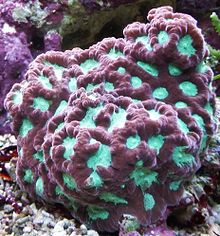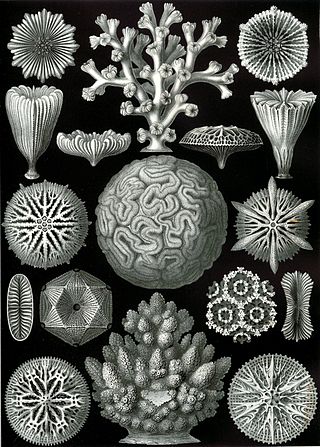
Scleractinia, also called stony corals or hard corals, are marine animals in the phylum Cnidaria that build themselves a hard skeleton. The individual animals are known as polyps and have a cylindrical body crowned by an oral disc in which a mouth is fringed with tentacles. Although some species are solitary, most are colonial. The founding polyp settles and starts to secrete calcium carbonate to protect its soft body. Solitary corals can be as much as 25 cm (10 in) across but in colonial species the polyps are usually only a few millimetres in diameter. These polyps reproduce asexually by budding, but remain attached to each other, forming a multi-polyp colony of clones with a common skeleton, which may be up to several metres in diameter or height according to species.

Montipora digitata, also known as finger coral, is a species of stony coral. It is found in shallow water in East Africa, the Indo-West Pacific, Kenya, Mozambique and Rodriguez.

Plerogyra sinuosa is a jelly-like species of the phylum Cnidaria. It is commonly called "bubble coral" due to its bubbly appearance. The "bubbles" are grape-sized which increase their surface area according to the amount of light available: they are larger during the day, but smaller during the night, when tentacles reach out to capture food. This species requires low light and a gentle water flow. Common names for Plerogyra sinuosa include "grape coral", bladder coral, and pearl coral. According to the IUCN, Plerogyra sinuosa ranges from the Red Sea and Madagascar in the western Indian Ocean to Okinawa and the Line Islands in the Pacific.
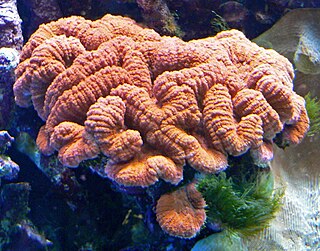
Lobophyllia hemprichii, commonly called lobed brain coral, lobed cactus coral or largebrain root coral, is a species of large polyp stony coral in the family Lobophylliidae. It is found in the Indo-Pacific Ocean. In its specific name Christian Gottfried Ehrenberg honoured his late partner the Prussian naturalist Wilhelm Hemprich; they were among the first to study the marine life of the Red Sea.

Acropora loripes is a species of branching colonial stony coral. It is common on reefs, upper reef slopes and reef flats in the tropical Indo-Pacific. Its type locality is the Great Barrier Reef.

Micromussa regularis is a species of coral found in Indo-Pacific waters from Australia to the western Pacific Ocean. It is usually uncommon throughout its range, but can be more common locally. It has a narrow depth range, and so is susceptible to coral bleaching and disease. It is also threatened by the global decline in coral reef habitats.
Alveopora fenestrata is a species of stony coral that is found in the Red Sea, the Gulf of Aden, the southwest and northern Indian Ocean, the central Indo-Pacific, Australia, Southeast Asia and the oceanic west Pacific Ocean. It can be found in shallow coral reefs, to a depth of 30 metres (100 ft). It is particularly susceptible to coral bleaching.

Paragoniastrea australensis, also known as the lesser star coral, is a species of stony corals in the family Merulinidae. It occurs in shallow water in the Indo-Pacific region.

Turbinaria stellulata, also known as disc coral, is a species of colonial stony coral in the family Dendrophylliidae. It is native to the Indo-Pacific region. The International Union for Conservation of Nature has rated its conservation status as being "vulnerable".

Turbinaria frondens, commonly known as disc coral, is a species of colonial stony coral in the family Dendrophylliidae. It is native to the Indo-Pacific region. It is a zooxanthellate coral that houses symbiont dinoflagellates in its tissues.
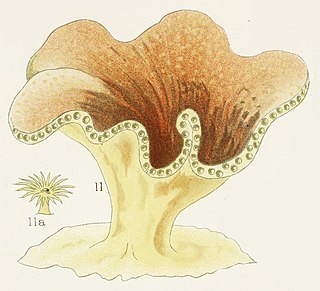
Turbinaria patula, commonly known as disc coral, is a species of colonial stony coral in the family Dendrophylliidae. It is native to the Indo-Pacific region, being found in the eastern Indian Ocean, northern Australia, the South China Sea and the western Pacific Ocean. It is a zooxanthellate coral that houses symbiont dinoflagellates in its tissues. It is an uncommon species and the International Union for Conservation of Nature (IUCN) has rated it as a "vulnerable" species.

Favites is a genus of stony corals in the family Merulinidae. Members of this genus are native to the Indo-Pacific region and their ranges extend from the Red Sea through the Indian Ocean and Western Pacific Ocean as far as Japan, the Line Islands and the Tuamotu Islands.
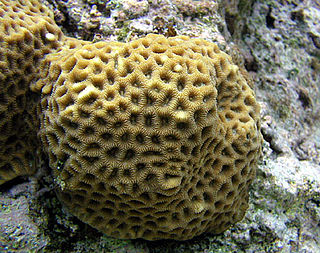
Favites abdita, also known as the larger star coral, is a species of stony coral in the family Merulinidae. It is native to the Indo-Pacific region and its range extends from East Africa and the Red Sea through the Indian Ocean to the Western Pacific Ocean. The International Union for Conservation of Nature has rated its conservation status as being "near-threatened".
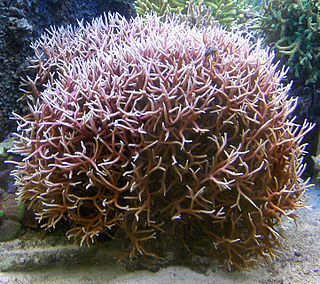
Seriatopora hystrix is a species of colonial stony coral in the family Pocilloporidae. It forms a branching clump and is commonly known as thin birdsnest coral. It grows in shallow water on fore-reef slopes or in sheltered lagoons, the type locality being the Red Sea. It is native to East Africa, the Red Sea and the western Indo-Pacific region. It is a common species and the International Union for Conservation of Nature has assessed its conservation status as being of "least concern".

Favites complanata is a species of stony coral in the family Merulinidae, sometimes known as the larger star coral. It is native to the Indo-Pacific region and its range extends from the Red Sea and Indian Ocean to the western and central Pacific Ocean. This is an uncommon species of coral and seems to be decreasing in abundance, and the International Union for Conservation of Nature has rated its conservation status as being "near threatened".

Oulophyllia crispa, sometimes called the intermediate valley coral, is a species of stony coral in the family Merulinidae. It is native to the tropical western and central Indo-Pacific region. Although this coral has a wide range, it is generally uncommon and seems to be decreasing in abundance, and the International Union for Conservation of Nature has rated its conservation status as being "near threatened".
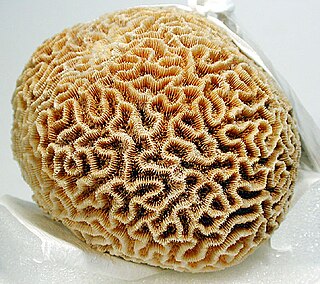
Goniastrea favulus, also known as the lesser star coral, is a species of stony coral in the family Merulinidae. It occurs in shallow water in the Indo-Pacific region. This is an uncommon species of coral and the International Union for Conservation of Nature has rated its conservation status as being "near threatened".

Heliofungia actiniformis is a solitary species of mushroom coral, a large polyp stony coral in the family Fungiidae. This coral is found in shallow water in the Indo-Pacific region. It is a zooxanthellate species. It is a popular coral in the reef aquarium trade; wild populations are threatened by disease, climate change, and over-collecting, and the species is considered vulnerable by the IUCN.
Favites spinosa is a species of stony coral in the family Merulinidae. It is native to the Indo-Pacific region, its range extending from the eastern coast of Africa through the Indian Ocean to the Western and Central Pacific Ocean.
Goniopora tenuidens is a species of colonial stony coral in the family Poritidae. It occurs in shallow water in the tropical Indo-Pacific region. The International Union for Conservation of Nature has assessed its conservation status as being of "least concern".
